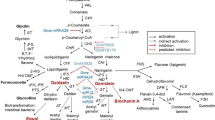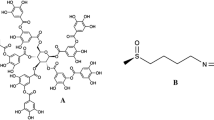Abstract
Isoflavone extracts from soybeans and soyfoods were treated with riboflavin photosensitization and changes in antioxidant activities of isoflavone extracts under riboflavin sensitization were determined using 2,2-diphenyl-1-picrylhydrazyl (DPPH), 2,2′-azino-bis(3-ethylbenzothiazoline-6-sulphonic acid) (ABTS), and ferric reducing antioxidant power (FRAP) assays. Extracts rich in malonyl derivatives, β-glucosides, and aglycones were prepared from raw, ovendried, and almond-incubated soybeans, and the fermented soyfoods cheongukjang and natto. As the period of visible light irradiation increased to 120 min, the total isoflavone content determined using HPLC decreased in all samples. Aglycones in almond-incubated extracts decreased by 77.5% after 120min, and β-glucosides in oven-dried extracts decreased by 52.0%. The radical scavenging activity based on DPPH and ABTS assays significantly (p<0.05) decreased in most extracts, compared with controls. The reducing power in aglycone- and β-glucoside-rich extracts increased, whereas the reducing power in extracts with high malonyl forms was not significantly (p>0.05) increased after riboflavin sensitization.
Similar content being viewed by others
References
Hendrich S, Wang GJ, Lin HK, Xu X, Tew BY, Wang HJ, Murphy PA. Isoflavone metabolism and bioavailability. pp. 211–230. In: Antioxidant Status, Diet, Nutrition, and Health. Papas AM (ed). CRC Press Inc., Boca Raton, FL, USA (1999)
Möller FJ, Diel P, Zierau O, Hertrampf T, Maaß J, Vollmer G. Longterm dietary isoflavone exposure enhances estrogen sensitivity of rat uterine responsiveness mediated through estrogen receptor a. Toxicol. Lett. 196: 142–153 (2010)
Lee JH, Renita M, Pioritto RJ, St. Martin SK, Schwartz SJ, Vodovotz Y. Isoflavone characterization and antioxidant activity of Ohio soybeans. J. Agr. Food Chem. 52: 2647–2651 (2004)
Shimoni E. Stability and shelf life of bioactive compounds during food processing and storage: Soy isoflavone. J. Food Sci. 69: R160–R166 (2004)
Uzzan M, Labuza TP. Critical issues in R&D of soy isoflavone enriched foods and dietary supplements. J. Food Sci. 69: CRH77-CRH86 (2004)
Min DB, Boff JM. Chemistry and reaction of singlet oxygen in foods. Compr. Rev. Food Sci. F. 1: 58–72 (2002)
Yang X, Zhao X, Hwang HM. Phototransformation of 2,4,6-trinitrotoluene: Sensitized by riboflavin under different irradiation spectral range. J. Hazard. Mater. 143: 271–276 (2007)
Zhao X, Hu X, Hwang HM. Effects of riboflavin on the phototransformation of benzo[a]pyrene. Chemosphere 63: 1116–1123 (2006)
Ha DO, Jeong MK, Park CU, Park MH, Chang PS, Lee JH. Effects of riboflavin photosensitization on the degradation of bisphenol A (BPA) in model and real food systems. J. Food Sci. 74: C380–C384 (2009)
King JM, Min DB. Riboflavin photosensitized singlet oxygen oxidation of vitamin D. J. Food Sci. 63: 31–34 (1998)
Yang SO, Lee SW, Chung H, Lee JH. Stability of isoflavone daidzein and genistein in riboflavin, chlorophyll b, or methylene blue photosensitization. J. Food Sci. 73: C100–C105 (2008)
Park CU, Yeo JD, Park MH, Park JB, Lee JH. Effects of riboflavinphotosensitization on daidzein and its photosensitized products. J. Food Sci. 75: C659–C666 (2010)
Seol NG, Kim MJ, Yi BR, Lee JH. Riboflavin photo-transformation of genistein and changes in radical scavenging activities of phototransformed genistein derivatives. Food Sci. Biotechnol. 23: 1055–1059 (2014)
Rice-Evans CA, Miller NJ, Paganga G. Structure-antioxidant activity relationships of flavonoids and phenolic acids. Free Radical Bio. Med. 20: 933–956 (1996)
Lebiedzinska A, Szefer P. Vitamins B in grain and cereal–grain food, soy-products and seeds. Food Chem. 95: 116–122 (2006)
Lee SW, Lee JH. Effects of oven-drying, roasting, and explosive puffing process on isoflavone distributions in soybeans. Food Chem. 112: 316–320 (2009)
Kim MJ, Park MH, Jeong MK, Yeo JD, Cho WI, Chang PS, Chung JH, Lee JH. Radical scavenging activity and anti-obesity effects in 3T3-L1 preadipocyte differentiation of ssuk (Artemisia princeps Pamp.) extract. Food Sci. Biotechnol. 19: 535–540 (2010)
Benzie IFF, Strain JJ. The ferric reducing ability of plasma (FRAP) as a measure of “antioxidant power”: The FRAP assay. Anal. Biochem. 239: 70–76 (1996)
Park MH, Jeong MK, Kim MJ, Lee JH. Modification of isoflavone profiles in a fermented soy-food with almond powder. J. Food Sci. 77: C125–C134 (2012)
Sohn MY, Seo KI, Lee SW, Choi SH, Sung NJ. Biological activities of cheonggukjang prepared with black bean and changes in phytoestrogen content during fermentation. Korean J. Food Sci. Technol. 32: 936–941 (2000)
Yang SO, Chang PS, Lee JH. Isoflavone distribution and ß-glucosidase activity in cheonggukjang, a traditional Korean whole soybean-fermented food. Food Sci. Biotechnol. 15: 96–101 (2006)
Yang SO, Lee SW, Park YW, Lee SJ, Chang PS, Choi SS, Lee JH. Succinyl daidzin and succinyl genistin are new isoflavone derivatives found in cheonggukjang. Food Sci. Biotechnol. 17: 172–175 (2008)
Toda T, Uesugi T, Hirai K, Nukaya H, Tsuji K, Ishida H. New 6-Oacyl isoflavone glycosides from soybeans fermented with Bacillus subtilis (natto). I. 6-O-succinylated isoflavone glycosides and their preventive effects on bone loss in ovariectomized rats fed a calciumdeficient diet. Biol. Pharm. Bull. 22: 1193–1201 (1999)
Author information
Authors and Affiliations
Corresponding author
Rights and permissions
About this article
Cite this article
Seol, N.G., Ka, H., Yi, B. et al. Changes in isoflavone profiles and antioxidant activities in isoflavone extracts from soybeans and soyfoods under riboflavin photosensitization. Food Sci Biotechnol 24, 1271–1277 (2015). https://doi.org/10.1007/s10068-015-0163-3
Received:
Revised:
Accepted:
Published:
Issue Date:
DOI: https://doi.org/10.1007/s10068-015-0163-3




